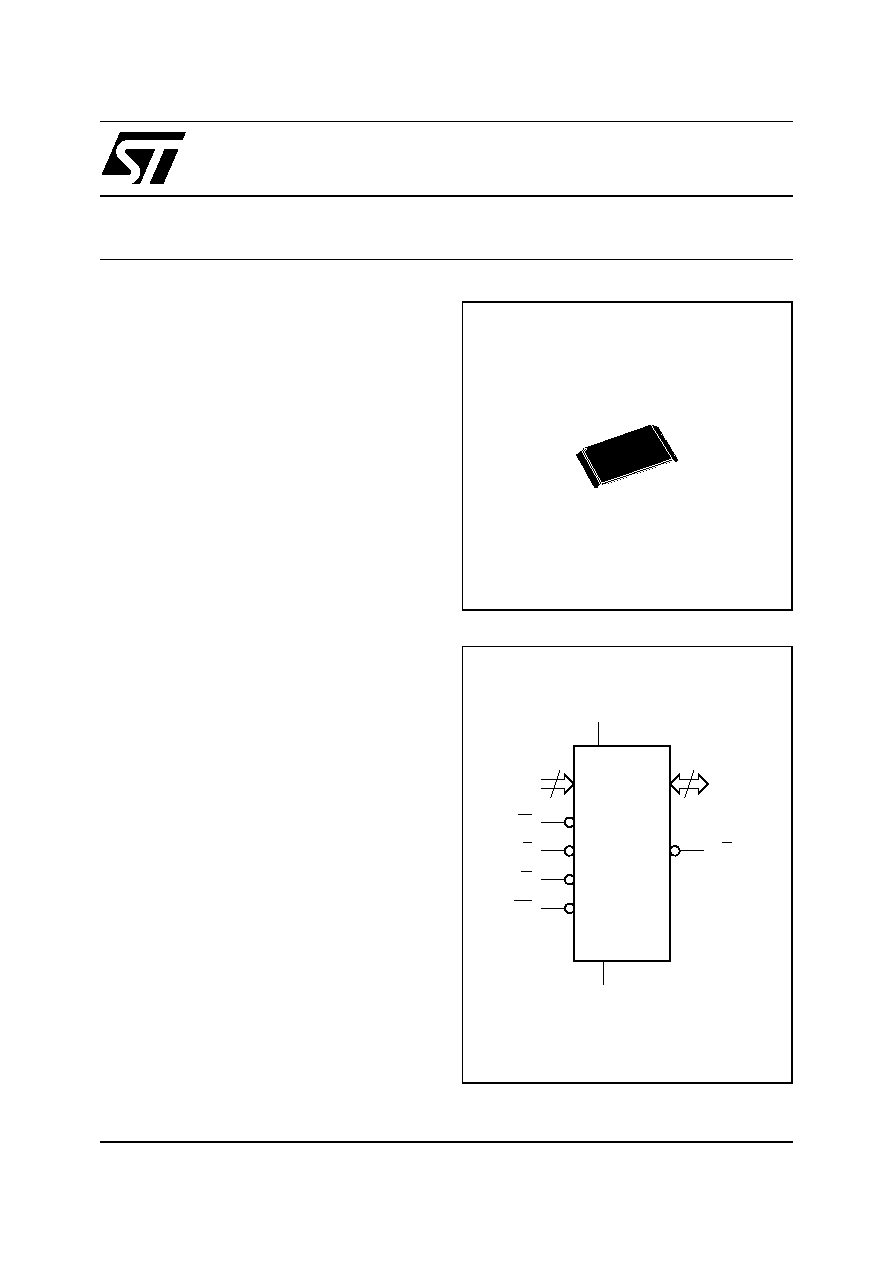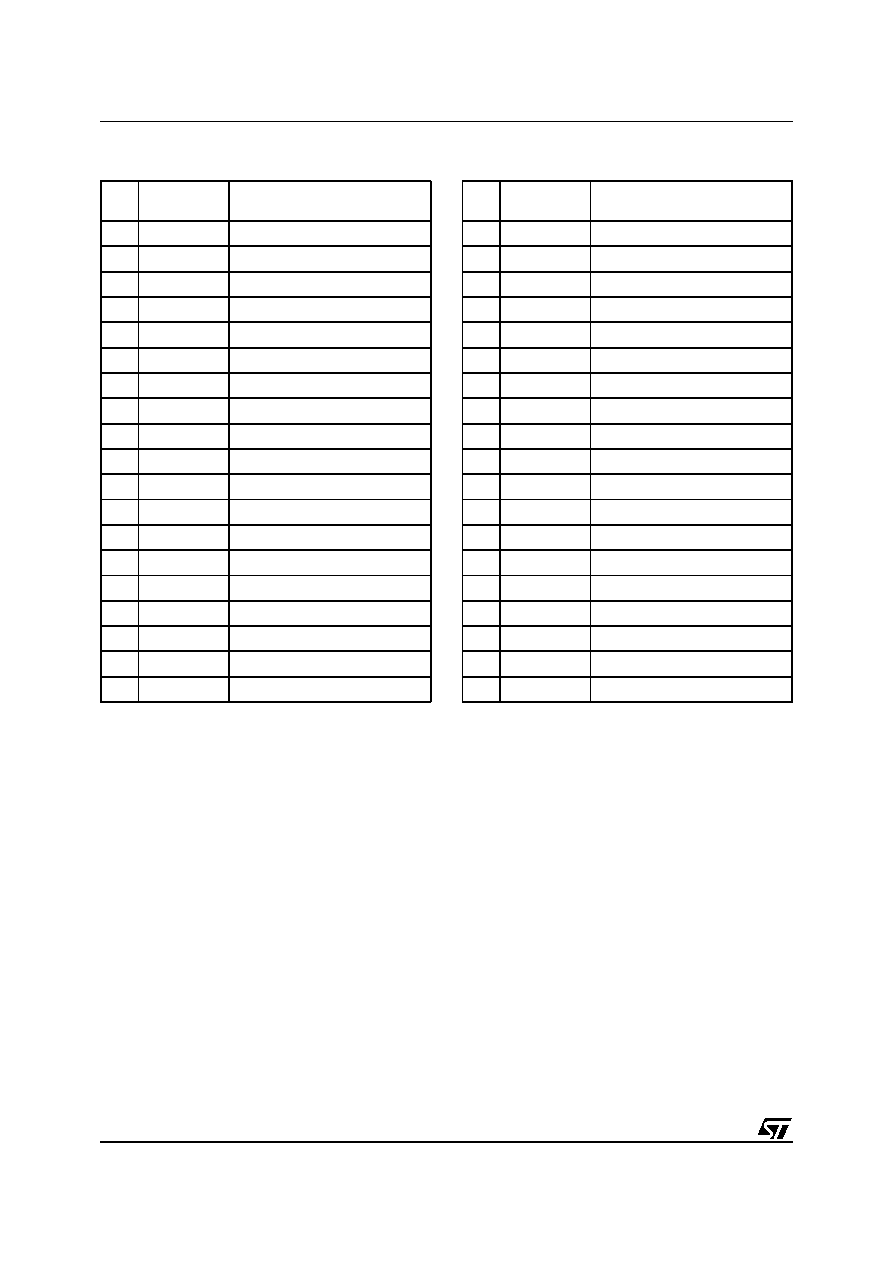
1/30
March 2000
M29W008AT
M29W008AB
8 Mbit (1Mb x8, Boot Block)
Low Voltage Single Supply Flash Memory
s
2.7V to 3.6V SUPPLY VOLTAGE for
PROGRAM, ERASE and READ OPERATIONS
s
ACCESS TIME: 80ns
s
PROGRAMMING TIME: 10µs typical
s
PROGRAM/ERASE CONTROLLER (P/E.C.)
≠ Program Byte-by-Byte
≠ Status Register bits and Ready/Busy Output
s
SECURITY PROTECTION MEMORY AREA
s
INSTRUCTIONS ADDRESS CODING: 3 digits
s
MEMORY BLOCKS
≠ Boot Block (Top or Bottom location)
≠ Parameter and Main blocks
s
BLOCK, MULTI-BLOCK and CHIP ERASE
s
MULTI BLOCK PROTECTION/TEMPORARY
UNPROTECTION MODES
s
ERASE SUSPEND and RESUME MODES
≠ Read and Program another Block during
Erase Suspend
s
LOW POWER CONSUMPTION
≠ Stand-by and Automatic Stand-by
s
100,000 PROGRAM/ERASE CYCLES per
BLOCK
s
20 YEARS DATA RETENTION
≠ Defectivity below 1ppm/year
s
ELECTRONIC SIGNATURE
≠ Manufacturer Code: 20h
≠ Top Device Code, M29W008AT: D2h
≠ Bottom Device Code, M29W008AB: DCh
Figure 1. Logic Diagram
AI02716
20
A0-A19
W
DQ0-DQ7
VCC
M29W008AT
M29W008AB
E
VSS
8
G
RP
RB
TSOP40 (N)
10 x 20mm

M29W008AT, M29W008AB
2/30
Figure 2. TSOP Connections
VSS
DQ1
DQ2
A7
A1
E
A4
A3
A11
A17
A14
A15
DQ7
A9
A16
G
NC
DQ5
DQ3
NC
VCC
DQ4
DQ6
A8
W
RB
A18
NC
RP
AI02717
M29W008AT
M29W008AB
10
1
11
20
21
30
31
40
A0
A12
A13
A19
A10
A5
A6
VCC
DQ0
VSS
A2
Table 1. Signal Names
A0-A19
Address Inputs
DQ0-DQ7
Data Input/Outputs, Command Inputs
E
Chip Enable
G
Output Enable
W
Write Enable
RP
Reset/Block Temporary Unprotect
RB
Ready/Busy Output
V
CC
Supply Voltage
V
SS
Ground
NC
Not Connected Internally
Organisation
The M29W008A is organised as 1Mb x8. The
memory uses the address inputs A0-A19 and the
Data Input/Outputs DQ0-DQ7. Memory control is
provided by Chip Enable E, Output Enable G and
Write Enable W inputs.
A Reset/Block Temporary Unprotection RP tri-lev-
el input provides a hardware reset when pulled
Low, and when held High (at V
ID
) temporarily un-
protects blocks previously protected allowing them
to be programed and erased. Erase and Program
operations are controlled by an internal Program/
Erase Controller (P/E.C.). Status Register data
output on DQ7 provides a Data Polling signal, and
DQ6 and DQ2 provide Toggle signals to indicate
the state of the P/E.C operations. A Ready/Busy
RB output indicates the completion of the internal
algorithms.
Memory Blocks
The devices feature asymmetrically blocked archi-
tecture providing system memory integration. Both
M29W008AT and M29W008AB devices have an
array of 19 blocks, one Boot Block of 16 Kbytes,
two Parameter Blocks of 8 Kbytes, one Main Block
of 32 Kbytes and fifteen Main Blocks of 64 Kbytes.
The M29W008AT has the Boot Block at the top of
the memory address space and the M29W008AB
locates the Boot Block starting at the bottom. The
memory maps are showed in Tables 3, 4. Each
block can be erased separately, any combination
of blocks can be specified for multi-block erase or
the entire chip may be erased. The Erase opera-
tions are managed automatically by the P/E.C.
DESCRIPTION
The M29W008A is a non-volatile memory that may
be erased electrically at the block or chip level and
programmed in-system on a Byte-by-Byte basis
using only a single 2.7V to 3.6V V
CC
supply. For
Program and Erase operations the necessary high
voltages are generated internally. The device can
also be programmed in standard programmers.
The array matrix organisation allows each block to
be erased and reprogrammed without affecting
other blocks. Blocks can be protected against pro-
graming and erase on programming equipment,
and temporarily unprotected to make changes in
the application. Each block can be programmed
and erased over 100,000 cycles.
Instructions for Read/Reset, Auto Select for read-
ing the Electronic Signature or Block Protection
status, Programming, Block and Chip Erase,
Erase Suspend and Resume are written to the de-
vice in cycles of commands to a Command Inter-
face using standard microprocessor write timings.
The device is offered in TSOP40 (10 x 20mm)
package.

3/30
M29W008AT, M29W008AB
Instructions
Seven instructions are defined to perform Read
Array, Auto Select (to read the Electronic Signa-
ture or Block Protection Status), Program, Block
Erase, Chip Erase, Erase Suspend and Erase Re-
sume. The internal P/E.C. automatically handles
all timing and verification of the Program and
Erase operations. The Status Register Data Poll-
ing, Toggle, Error bits and the RB output may be
read at any time, during programming or erase, to
monitor the progress of the operation.
Instructions are composed of up to six cycles. The
first two cycles input a Coded sequence to the
Command Interface which is common to all in-
structions (see Table 9). The third cycle inputs the
instruction set-up command. Subsequent cycles
output the addressed data, Electronic Signature or
Block Protection Status for Read operations. In or-
der to give additional data protection, the instruc-
tions for Program and Block or Chip Erase require
further command inputs. For a Program instruc-
tion, the fourth command cycle inputs the address
and data to be programmed. For an Erase instruc-
tion (Block or Chip), the fourth and fifth cycles in-
put a further Coded sequence before the Erase
confirm command on the sixth cycle. Erasure of a
memory block may be suspended, in order to read
data from another block or to program data in an-
other block, and then resumed.
When power is first applied or if V
CC
falls below V
L-
KO
, the command interface is reset to Read Array.
The block erase operation can be suspended in
order to read from or program to any block not be-
ing erased, and then resumed.
Block protection provides additional data security.
Each block can be separately protected or unpro-
tected against Program or Erase on programming
equipment. All previously protected blocks can be
temporarily unprotected in the application.
Bus Operations
The following operations can be performed using
the appropriate bus cycles: Read (Array, Electron-
ic Signature, Block Protection Status), Write com-
mand, Output Disable, Stand-by, Reset, Block
Protection, Unprotection, Protection Verify, Unpro-
tection Verify and Block Temporary Unprotection.
See Tables 5 and 6.
Command Interface
Instructions, made up of commands written in cy-
cles, can be given to the Program/Erase Controller
through a Command Interface (C.I.). For added
data protection, program or erase execution starts
after 4 or 6 cycles. The first, second, fourth and
fifth cycles are used to input Coded cycles to the
C.I. This Coded sequence is the same for all Pro-
gram/Erase Controller instructions. The 'Com-
mand' itself and its confirmation, when applicable,
are given on the third, fourth or sixth cycles. Any
incorrect command or any improper command se-
quence will reset the device to Read Array mode.
Table 2. Absolute Maximum Ratings
(1)
Note: 1. Except for the rating "Operating Temperature Range", stresses above those listed in the Table "Absolute Maximum Ratings" may
cause permanent damage to the device. These are stress ratings only and operation of the device at these or any other conditions
above those indicated in the Operating sections of this specification is not implied. Exposure to Absolute Maximum Rating condi-
tions for extended periods may affect device reliability. Refer also to the STMicroelectronics SURE Program and other relevant qual-
ity documents.
2. Minimum Voltage may undershoot to ≠2V during transition and for less than 20ns during transitions.
3. Depends on range.
Symbol
Parameter
Value
Unit
T
A
Ambient Operating Temperature
(3)
≠40 to 85
∞C
T
BIAS
Temperature Under Bias
≠50 to 125
∞C
T
STG
Storage Temperature
≠65 to 150
∞C
V
IO
(2)
Input or Output Voltage
≠0.6 to 5
V
V
CC
Supply Voltage
≠0.6 to 5
V
V
(A9, E, G, RP)
(2)
A9, E, G, RP Voltage
≠0.6 to 13.5
V

M29W008AT, M29W008AB
4/30
Table 3. Top Boot Block Addresses,
M29W008AT
#
Size
(Kbytes)
Address Range
18
16
FC000h-FFFFFh
17
8
FA000h-FBFFFh
16
8
F8000h-F9FFFh
15
32
F0000h-F7FFFh
14
64
E0000h-EFFFFh
13
64
D0000h-DFFFFh
12
64
C0000h-CFFFFh
11
64
B0000h-BFFFFh
10
64
A0000h-AFFFFh
9
64
90000h-9FFFFh
8
64
80000h-8FFFFh
7
64
70000h-7FFFFh
6
64
60000h-6FFFFh
5
64
50000h-5FFFFh
4
64
40000h-4FFFFh
3
64
30000h-3FFFFh
2
64
20000h-2FFFFh
1
64
10000h-1FFFFh
0
64
00000h-0FFFFh
Table 4. Bottom Boot Block Addresses,
M29W008AB
#
Size
(Kbytes)
Address Range
18
64
F0000h-FFFFFh
17
64
E0000h-EFFFFh
16
64
D0000h-DFFFFh
15
64
C0000h-CFFFFh
14
64
B0000h-BFFFFh
13
64
A0000h-AFFFFh
12
64
90000h-9FFFFh
11
64
80000h-8FFFFh
10
64
70000h-7FFFFh
9
64
60000h-6FFFFh
8
64
50000h-5FFFFh
7
64
40000h-4FFFFh
6
64
30000h-3FFFFh
5
64
20000h-2FFFFh
4
64
10000h-1FFFFh
3
32
08000h-0FFFFh
2
8
06000h-07FFFh
1
8
04000h-05FFFh
0
16
00000h-03FFFh

5/30
M29W008AT, M29W008AB
SIGNAL DESCRIPTIONS
See Figure 1 and Table 1.
Address Inputs (A0-A19). The address inputs
for the memory array are latched during a write op-
eration on the falling edge of Chip Enable E or
Write Enable W. When A9 is raised to V
ID
, either a
Read Electronic Signature Manufacturer or Device
Code, Block Protection Status or a Write Block
Protection or Block Unprotection is enabled de-
pending on the combination of levels on A0, A1
A6, A12 and A15.
Data Input/Outputs (DQ0-DQ7). The input is
data to be programmed in the memory array or a
command to be written to the C.I. Both are latched
on the rising edge of Chip Enable E or Write En-
able W. The output is data from the Memory Array,
the Electronic Signature Manufacturer or Device
codes, the Block Protection Status or the Status
register Data Polling bit DQ7, the Toggle Bits DQ6
and DQ2, the Error bit DQ5 or the Erase Timer bit
DQ3. Outputs are valid when Chip Enable E and
Output Enable G are active. The output is high im-
pedance when the chip is deselected or the out-
puts are disabled and when RP is at a Low level.
Chip Enable (E). The Chip Enable input acti-
vates the memory control logic, input buffers, de-
coders and sense amplifiers. E High deselects the
memory and reduces the power consumption to
the stand-by level. E can also be used to control
writing to the command register and to the memo-
ry array, while W remains at a low level. The Chip
Enable must be forced to V
ID
during the Block Un-
protection operation.
Output Enable (G). The Output Enable gates the
outputs through the data buffers during a read op-
eration. When G is High the outputs are High im-
pedance. G must be forced to V
ID
level during
Block Protection and Unprotection operations.
Write Enable (W). This input controls writing to
the Command Register and Address and Data
latches.
Ready/Busy Output (RB). Ready/Busy is an
open-drain output and gives the internal state of
the P/E.C. of the device. When RB is Low, the de-
vice is Busy with a Program or Erase operation
and it will not accept any additional program or
erase instructions except the Erase Suspend in-
struction.
When RB is High, the device is ready for any
Read, Program or Erase operation. The RB will
also be High when the memory is put in Erase
Suspend or Stand-by modes.
Reset/Block Temporary Unprotect Input (RP).
The RP Input provides hardware reset and pro-
tected block(s) temporary unprotection functions.
Reset of the memory is achieved by pulling RP to
V
IL
for at least t
PLPX
. When the reset pulse is giv-
en, if the memory is in Read or Stand-by modes, it
will be available for new operations in t
PHEL
after
the rising edge of RP.
If the memory is in Erase, Erase Suspend or Pro-
gram modes the reset will take t
PLYH
during which
the RB signal will be held at V
IL
. The end of the
memory reset will be indicated by the rising edge
of RB. A hardware reset during an Erase or Pro-
gram operation will corrupt the data being pro-
grammed or the sector(s) being erased. See
Tables 15, 16 and Figure 8.
Temporary block unprotection is made by holding
RP at V
ID
. In this condition previously protected
blocks can be programmed or erased. The transi-
tion of RP from V
IH
to V
ID
must slower than t
PH-
PHH
. (See Tables 17, 18 and Figure 8). When RP
is returned from V
ID
to V
IH
all blocks temporarily
unprotected will be again protected.
V
CC
Supply Voltage. The power supply for all
operations (Read, Program and Erase).
V
SS
Ground. V
SS
is the reference for all voltage
measurements.




